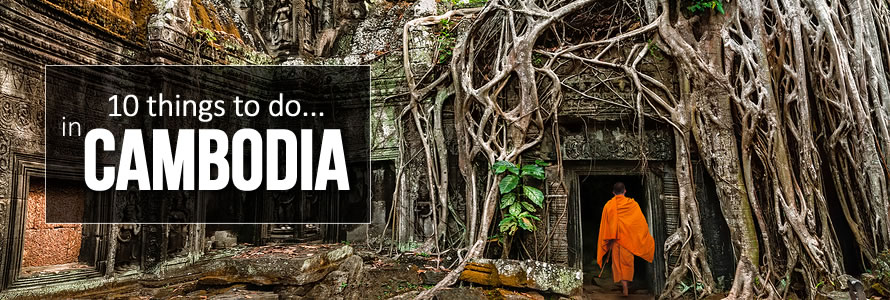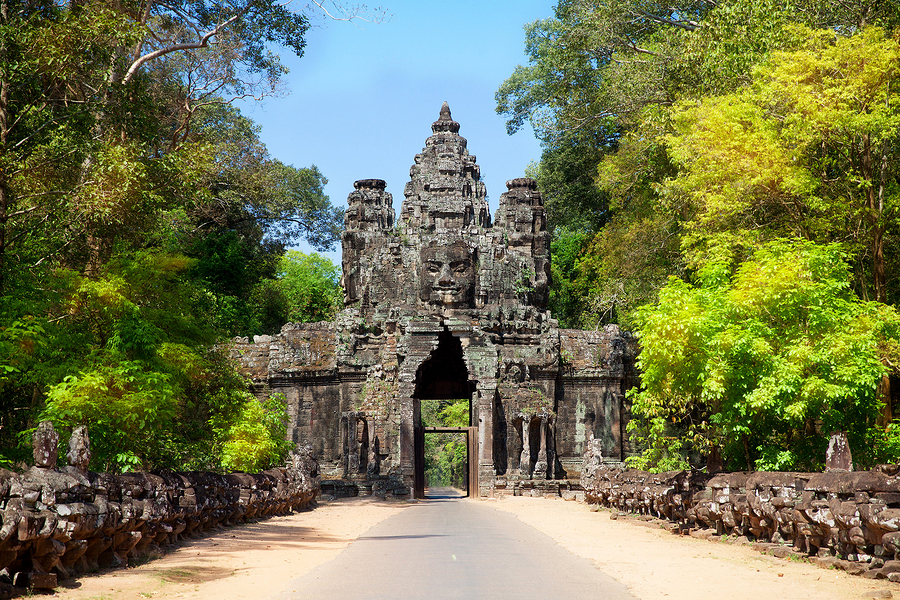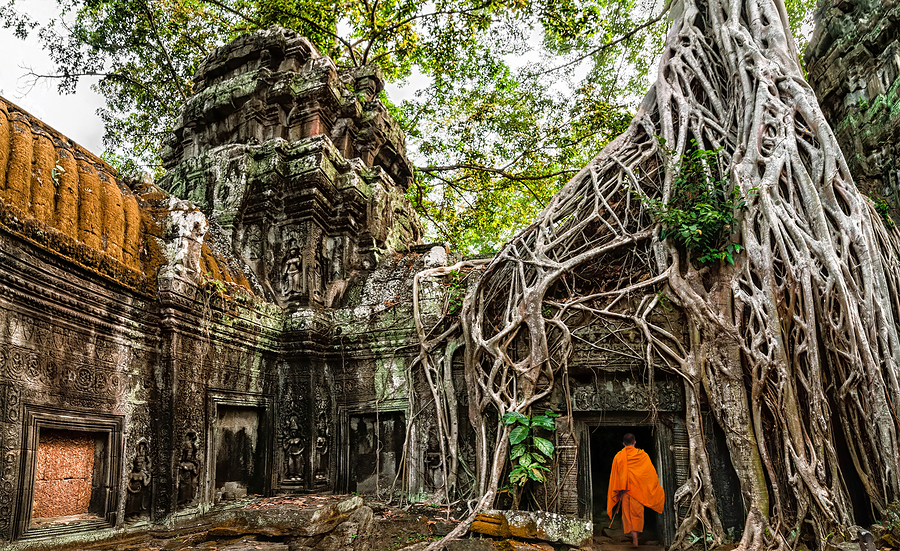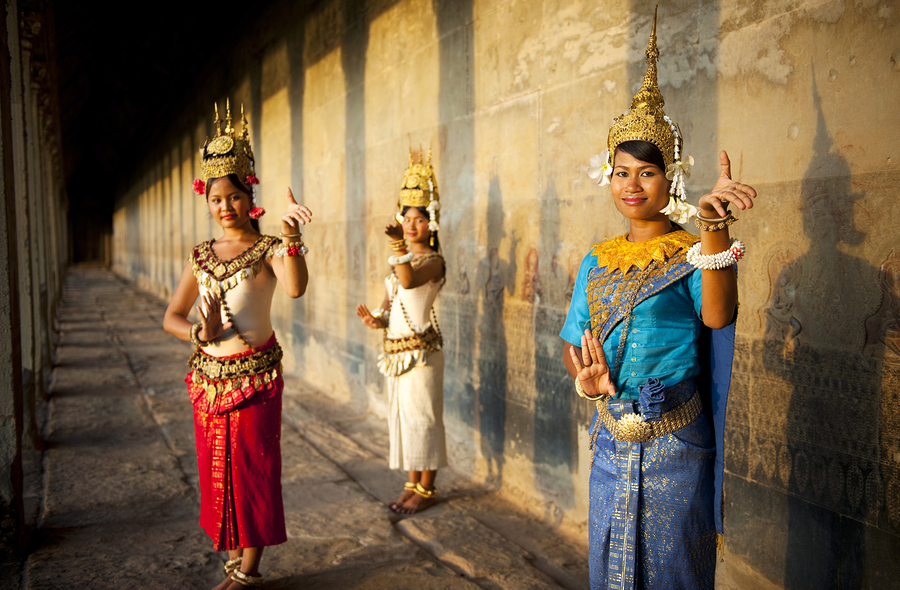Dishing up all the colour and charming chaos you’d expect to find in South East Asia, Cambodia also has some very special experiences and must-sees all of its very own. The country has, for some time now, been part of the established backpacker circuit and with good reason.
If you’re travelling in South East Asia during your gap year, Cambodia is well worth a visit, with numerous things to see and do! You can plunge into the jungle for a few days of wildlife encounters and indigenous immersion; you can visit the largest religious monument anywhere on earth or go all Indiana Jones, meandering the weaving passageways of the tree-entwined temple used in the ‘Tomb Raider movie; you can be dazzled by the 10,000 diamonds encrusting a Buddha at the Royal Palace of Phnom Penh or ride an illegal bamboo train. Alternatively you can do very little except cloud watch and ocean gaze while basking on a white sand beach lapped by the bluer than blue waters of the South China Sea. You’re going to be spoilt for choice, but here are our top 10 things to do & see in Cambodia to get you started.
1) The Angkor Temples
Along with many other iconic wonders on the planet such as Machu Picchu and the Egyptian pyramids, many of us are familiar with images of the Angkor temples even if we’ve never set foot in Cambodia. And little wonder – this UNESCO World Heritage listed 12th century temple complex which serves as a pilgrimage destination for the devout, is the largest religious monument anywhere on the planet.
Yes, the site is on a far too well-beaten tourist trail, yes the world and his wife will have managed to rise pre-dawn to come and watch the sunset here – but still it has to be done when travelling in Cambodia and you won’t regret it!
Forgotten by all but ghosts the complex lay hidden beneath the twisting branches, roots and vines of the jungle until it was unearthed by the French in the 1800s – incredibly well-preserved (the temples not the French that is!) This romantically-toned resurrection to glory along with the beauty and breathtaking scale of the temples ensures the visitors just keep on coming. You can do a self-tour but if you really want to know what it is you are looking at you’ll need to employ the services of a guide. Choose wisely – these come in all guises from totally useless rip-off artists to the wonderfully educational and worth every penny (or riel to be more precise).
The Angkor title also encompasses the Bayon Temple of Angkor Thom with its maze of galleries, seemingly endless towers and passages on three levels. The 4 metre high carved stone faces are the big draw here and tend to epitomise most folks’ idea of Khmer architecture.
2) Tonle Sap Lake and the ‘Floating’ Villages
If you look at a map of Cambodia you can’t fail to spot the big blob of blue in the mid-west – this is Tonle Sap Lake – the largest freshwater lake in South East Asia. This is an unusual lake – in the rainy season the lake swells massively in size and the flow of the Tonle Sap River, which drains the lake in dry season, is reversed as the mighty Mekong hits full flood.
Rainy season is therefore the time to visit. This is when the lake’s villages made up of houses on stilts appear to be floating and also when forays into the flooded forests and wildlife reserves get interesting. More than 5 million folk call the lake home – almost 1 ½ million living in the floating villages – and almost all of them make their living by fishing or agriculture.
The houses themselves offer both fascinating and sobering glimpses of the subsistence living of these people. Some structures barely classify as houses; some most definitely identified themselves as boats in former lives while many look as if nothing but hope is holding them together. Most definitely not ramshackle though is the cheerful splash of colour presented by the sunshine coloured temple – also ‘floating’ on the lake. You can meander around under your own steam but tours make life simpler and you’ll get to see more. Home stays are available but, as they are typically of the authentic experience kind, may not be everyone’s cup of tea.
3) Tuol Sleng Genocide Museum and The Killing Fields – Phnom Penh
Unless you’ve spent your life in a hobbit-hole you’ll probably know at least a little about Cambodia’s tragic and shocking past. From 1975 to 1979 Pol Pot and his communist Khmer Rouge regime were responsible for the deaths of an estimated 3 million fellow Cambodians in one of the worst cases of genocide the planet has ever known.
The former school which became the interrogation centre known as S-21 for extracting ‘confessions’ under torture from, among others, intellectual and professional individuals is now the Tuol Sleng Museum. Around 17,000 people were known to have been kept here during those fateful years including children – only 7 survived.
15 km from Phnom Penh is Choeung Ek – one of the thousands of sites spread throughout the country known collectively as the ‘Killing Fields’. Choeung Ek – the best known of the killing field sites – is where the S21 prisoners were brought after their confessions to be executed and buried.
After the Khmer Rouge was toppled thousands of bodies were found here. Some of the skulls and bones of these victims today form what is both a shocking and poignant monument in the Memorial Stupa. Arranged by sex and age this heart-rending and haunting sight makes for a hard-to-ignore tribute and tragic reminder of so many wasted lives. Many mass-grave burial pits at the site have been intentionally left undisturbed which means no-one knows for sure just how many souls ended their days here.
No-one can pretend that visiting these sites is an easy thing to do but, to have any hope of understanding what this country has undergone and how it has been shaped since, it is necessary.
4) Ta Prohm – Siem Reap
Ta Prohm is technically part of the Angkor complex – considered the third most significant after Angkor Wat and the Bayon Temple of Angkor Thom. However, smaller, situated a little out on its own and east of Angkor Thom this highly atmospheric site (many would say THE most evocative of the entire complex) cane get missed. Why evocative? Well, this jungle temple has pretty much been left as it was found in 1860 – a fantastically romantic and Tolkien-esque interweaving of snaking tree roots and partly crumbled ancient temple. The colour-splashes of parrots in the trees and monkeys clambering among this sprawling ancient monastery of dark passageways and labyrinthine galleries just add to the whole effect. And if it instantly makes you think ‘Tomb Raider’ that’s because Ta Prohm was the set for both movie and game.
5) Phnom Penh
Once dubbed the ‘pearl of Asia’ Cambodia’s capital exudes charming chaos and also boasts one of the most stunning river-fronts to be found for miles in every direction. Fluttering flags, swaying palms and occasional street performances catch the eye and sooth the senses as you meander along the traffic-free flag-stoned walkway and sunsets can be of the spectacular variety.
There’s plenty to do here including a wonderful National Museum but the Royal Palace and Silver Pagoda should be an essential part of any visit. Inside the walled perimeter of the palace complex traffic noise seems to be shut off and the various royal buildings and tropical gardens present an oasis of calm and tranquillity. Top of the must-sees here include the 17th century crystal ‘Emerald Buddha’ and another close by which is decorated with almost 10,000 diamonds. The silver Pagoda, so named because of its solid silver tiled floor, was originally built in the mid 1800s.
6) Battambang
Once part of ancient Siam, the riverside located town of Battambang represents to many the real Cambodia and a little slice of just what they have been looking for. As preserved French colonial towns go this is one of the best – certainly in Cambodia – and a foray into the surrounding countryside will reward the adventurer with a temple or two worth seeing. Size-wise don’t be expecting Angkor Wat proportions but, unlike this famous complex, you could have these temples all to yourself.
Make sure you hitch yourself a ride on one of the bamboo ‘trains’ while you’re in town. Little more than a glorified trolley on wheels, these bamboo decked contraptions which have often utilised the engine and wheels from wartime tanks, carry both cargo and people between Battambang and Phnom Penh. Technically illegal, the train chug has become an almost essential inclusion on the tourist itinerary which can be arranged through hotels, hostels or tuk-tuk drivers.
Also not to be missed is the 6 ½ m ‘Naga for Peace’ monument just south of town which is elegant and beautiful from a distance but beyond awesome up close. Cambodia’s history of conflict has meant thousands upon thousands of illegal weapons found their way into the hands of ordinary citizens. This stylised multi-headed serpent or naga has been built entirely from those surrendered weapons and weapon parts.
7) Apsaras Dance
Nothing brings to life the colour and spirit of a culture quite like its traditional dance or performing arts and the apsaras dance of Cambodia is no exception. Drawing inspiration from its celestial dancing namesake in Hindu and Buddhist mythology as a female spirit of waters and clouds, apsara has ancient roots. However, in its present form it is a fairly modern revival – championed by Queen Sisowath Kossomak Nearirath Serey Vatthana in the 1940s after watching a school performance. Her granddaughter Princess Norodom Buppha Devi later became the first professional apsara dancer of the modern era.
Elegance, mystery, drama and melody intertwine during performances which will have you marvelling at the decidedly abnormal contortions of the dancers’ hands. Some shows are put on purely for the benefit of tourists particularly in Siem Reap where full shows typically include all 4 elements of traditional Khmer dance – apsara, masked, shadow theatre and folk. Alternatively you might also catch some good performances in the town’s restaurants and cafés.
In Phnom Penh you can watch dancers training at performing art schools open to the public or, best of all, check out one of the Friday or Saturday night cultural shows staged by the students of Sovanna Phum Art Association. Apsara along with shadow puppet theatre, mask dances and folk dances are all here and blissfully free of the rather more manufactured tourist atmosphere of Siem Reap.
8) Irrawaddy River Dolphins – Kratie
The crumbling and faded colonial grandeur of Kratie gives the town a certain charm which may be why some come here but it is something else entirely which gives the town a real extra-special string to its bow. Kratie is the gateway for those wishing to get up-close-and-personal with the critically endangered and rare Irrawaddy dolphin. There are only a handful of freshwater dolphin species in the world so catching sight of one is a something of a once-in-a-lifetime experience.
Ticking that one off your bucket list is highly likely here because around 20 of these Irrawaddy dolphins – a close relative of the killer whale – call a stretch of the Mekong between Cambodia and Laos home. Late afternoon and early evening are good times to head out as not only are the dolphins often more active around then but you might also catch yourself once of those epic Mekong sunsets. A little boat, the soft splashing of the river, dolphins breaking the calm surface and the sky on fire – it probably doesn’t get any better than that.
9) Sihanoukville – Beach Bumming and Island Escapes
Sandwiched between Vietnam, Laos and Thailand Cambodia doesn’t have much coastline to call its own but what it can claim falls quite often into the idyllic category of white sand, turquoise water and bamboo beach huts.
Topping the lists for backpacker hedonism and perhaps most easily accessible are the many beach choices of Sihanoukville. These range in type from the high buzz scene of the central town beach to the high-end mellow vibe and tropically postcard-perfect setting of several others.
Just off Sihanoukville’s coast lies super-laid back little Bamboo Island or Koh Russei in the local parlance. A boat ride of about 45 minutes will deposit you on a Robinson Crusoe-like island free of TV, Internet, roads and even electricity after the generators power down for the evening. You can come for the day but if you decide to opt for one of the budget dorm and bungalow accommodation choices right on the beach you may have the island more or less to yourself once the last 4pm ferry leaves.
10) Ratanakiri
If you like your experiences nature-rich and wild and you’re a bit of a hiking/trekking enthusiast the Ratanakiri region will be your Mecca. Almost 50% of this entire region has become conservation protected and includes Lomphat Wildlife Sanctuary and Virachey National Park.
Located in the country’s remote north-east, Ratanakiri’s geographical make up is an incredibly varied patchwork of hills, mountains, plateaus, rainforest and crater lakes. Boasting one of the most diverse lowland tropical rainforest ecosystems found anywhere in South East Asia the list of possible animal sightings here reads like a natural world’s who’s who. Among the 44 mammal species, 76 bird species, 9 reptile species and a bewilderingly large diversity of trees and flowers numbering into their hundreds can be found Asian elephant, leopard, sun bear, gibbon and Malayan porcupine as well as python, tortoise, water monitor and far too many others to list.
Simply immersing yourself in this environment is good for the soul and there are plenty of companies ready, willing and able to take you in for a few hours or a few days. Expect jungle waterfall swimming, encounters with indigenous people whose heritage stretches back before the country was even Cambodia, jungle camping and homestays. Head to the area’s capital at Ban Lung to see what’s on offer from the jungle immersion menu.




